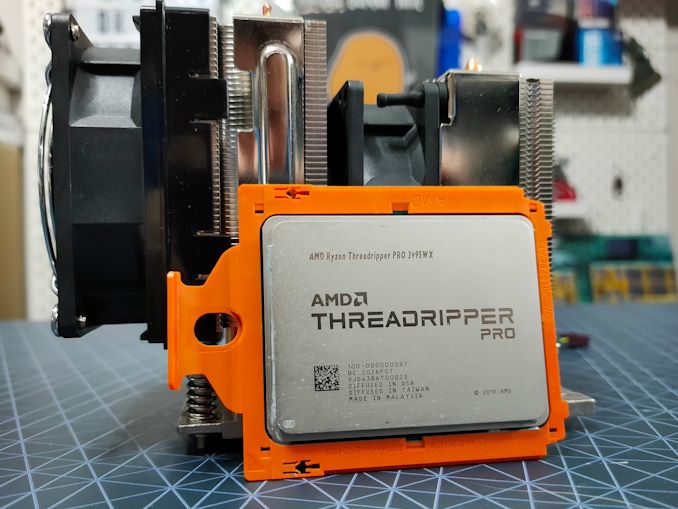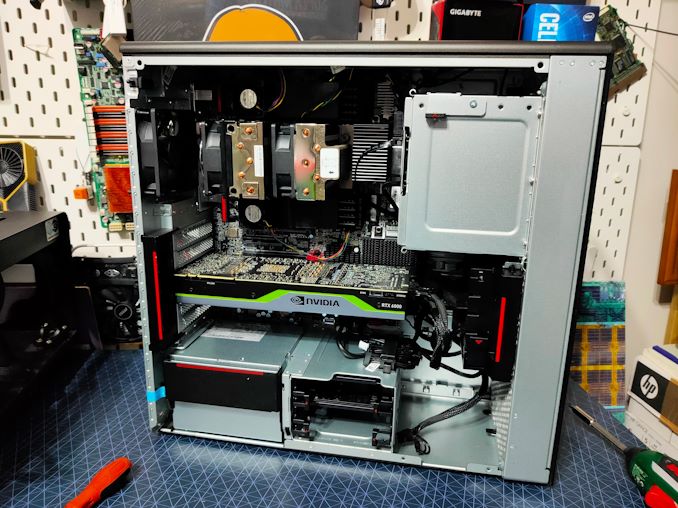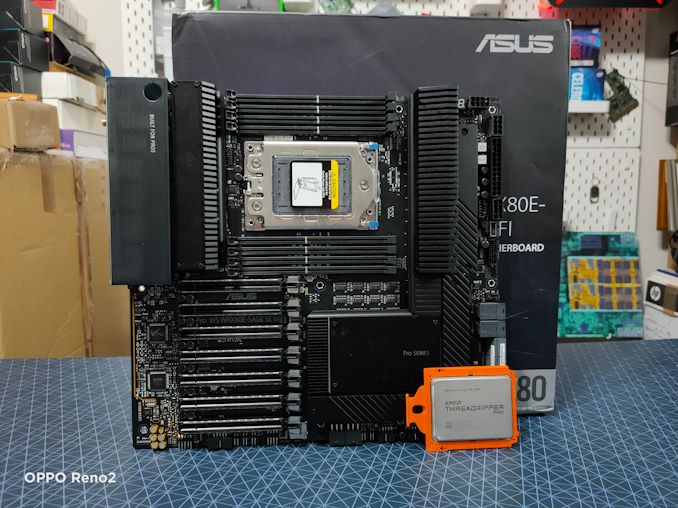64 Cores of Rendering Madness: The AMD Threadripper Pro 3995WX Review
by Dr. Ian Cutress on February 9, 2021 9:00 AM EST- Posted in
- CPUs
- AMD
- Lenovo
- ThinkStation
- Threadripper Pro
- WRX80
- 3995WX
Conclusions: Faster Than Expected
When I started testing for this review, looking purely at the specification sheet, I was expecting AMD’s Threadripper Pro 3995WX to come in just behind the 3990X in most of our testing. The same amount of cores, the same TDP, but slightly lower on frequencies in exchange for double the memory channels and 8x the memory support (also Pro features). More often than not our processor comparisons are usually testing systems with identical memory systems, or we don’t consider that memory difference that major in most of our testing. After going through the end data for this review, it would appear that it makes more of a difference than we initially had thought.
In the tests that matter, most noticeably the 3D rendering tests, we’re seeing a 3% speed-up on the Threadripper Pro compared to the regular Threadripper at the same memory frequency and sub-timings. The core frequencies were preferential on the 3990X, but the memory bandwidth of the 3995WX is obviously helping to a small degree, enough to pull ahead in our testing, along with the benefit of having access to 8x of the memory capacity as well as Pro features for proper enterprise-level administration.
The downside of this comparison is the cost: the SEP difference is +$1500, or another 50%, for the Threadripper Pro 3995WX over the regular Threadripper 3990X. With this price increase, you’re not really paying +50% for the performance difference (ECC memory also costs a good amount), but the feature set. Threadripper Pro is aimed at the visual effects and rendering market, where holding 3D models in main memory is a key aspect of workflow speed as well as full-scene production. Alongside the memory capacity difference, having double the PCIe 4.0 lanes means more access to offload hardware or additional fast storage, also important tools in the visual effects space. Threadripper Pro falls very much into the bucket of 'if you need it, this is the option to go for'.
For our testing, we used the Lenovo Thinkstation P620, the first Threadripper Pro system available in the market, and we’ll have a full review on it shortly. The Thinkstation Pro systems are always well designed workstations with longevity and professional workloads in mind, enabling 280 W cooling with a fun heatsink but also additional custom DRAM fans, a unique motherboard with an easily removable power supply, and support and space for a number of add-in cards. Lenovo’s units, if you buy them individually from the website, are eye-wateringly expensive (+$12200 for the 64-core CPU, a +120% markup), and it is recommended that any design studio that wants to test or order these units should work through a local distributor.
AMD is set to push Threadripper Pro into the consumer and commercial markets beyond Lenovo later this quarter. We have already been in touch with local regional system integrators who are already examining their options based on the three Threadripper Pro motherboards set to be available in the market from ASUS, GIGABYTE, and Supermicro. We are expecting a range of options to be available, and most design studios are likely to order pre-built systems with a variety of air and liquid cooling.
What might confuse a few users is that AMD is launching Threadripper Pro into the major market now, right on the cusp of its next-generation EPYC launch in the next eight weeks. These new EPYC processors should afford a sizeable raw compute upgrade moving to Zen 3 cores, all while Threadripper Pro is on Zen 2. As we saw comparing TR Pro to EPYC in this review, both on Zen 2, in some circumstances it is the push up to 280 W where TR Pro gets the best performance, and a 280 W version of next-generation EPYC might seem more appealing to users looking at TR Pro today. What exactly AMD will launch for EPYC is unknown, whereas TR Pro on this generation is now a known performance factor that system integrators are building on for the workstation market. EPYC never really fit into the workstation market that easily, which is why TR Pro exists today.
We have heard some conflicting dates as to when exactly Threadripper Pro will come to the mass market beyond Lenovo, but they all fall within Q1. We have reached out to AMD in order to source the other processors for our testing.














118 Comments
View All Comments
Fellovv - Tuesday, February 9, 2021 - link
Agreed— picked up a p620 with 16c for $2500, could have gotten it for lower from Lenovo if they didn’t have weeks of lead time. Ian- you may see Lenovo discounts all the crazy prices about 50% all year, and sometimes there are Honey coupons to knock off hundreds more.I have read that the 16c 2 CCX 3955WX May only get 4 channel RAM, not the full 8. I may be able to confirm in the near future. Gracias for the fine and thorough review. My only request is to ensure the TR 3990 is included in every graph— it was MIA or AWOL in several. I went with they TR Pro for the RAM and PCIe 4 lanes. Seeing the results confirms it was a good choice for me. Can’t wait for the Zen3!
realbabilu - Tuesday, February 9, 2021 - link
Nice 👍 about mkl, how about blis and open las,.did it suffer high multi core problemMonkeyMan73 - Wednesday, February 10, 2021 - link
AMD has the performance crown in most scenarios, but it comes at an extremely high price point. Might not be worth this kind of money even for most extreme power user. Maybe get a dual core Xeon? Might be cheaper.BTW, your las pic of this review is definitly not an OPPO Reno 2 :)
MonkeyMan73 - Wednesday, February 10, 2021 - link
Apologies, not a Dual core Xeon, that will not cut it but meant a Dual Socket Xeon setup.Oxford Guy - Wednesday, February 10, 2021 - link
The worst aspect of the price-to-performance is that it’s using outdated tech rather than Zen 3.MonkeyMan73 - Sunday, February 28, 2021 - link
Correct, there is always some sort of trade-off.Greg13 - Wednesday, February 10, 2021 - link
I feel like you guys really need to get some more memory intensive workloads to test. So often in these Threadripper / Threadripper Pro / EPYC reviews, the consumer CPU (5950X in this case) is often faster or not far behind even on highly multithreaded applications. I do some pretty large thermal fluid system simulations in Simscape where by once a system is designed I use an optimisation algorithm to find the optimal operating parameters of the system. This involves running multiple simulations of the same model in parallel using Matlab Parallel computing toolbox along with their global optimisation toolbox. Last year I bought a 3950X and 128GB ram to do this, but as far as I can tell it is massivly memory bandwidth limited. It's also memory capacity limited too... Each simulation uses around 10GB ram each, so I generally only run 12 parallel workers to keep within the 128GB of ram. However, In terms of throughput I see barely any change when dropping down to 8 parallel workers, suggesting, I think that with 12 workers, it's massivly memory bandwidth limited. This also seems to be the case in terms of the CPU power, even with 12 workers going, the CPU power reported is pretty low, which leads me to think it's waiting for data from memory?I assume that this would be better with Threadripper or even better with Threadripper Pro with their double and quadrouple memory bandwidth. However I don't have the funds to buy a selection of kit and test it to see if the extra cost is worth it. It would be good if you guys could add some more memory intensive tests to the suite (ideally for me some parallel Simscape simulations!) to show the benefit these extra memory channels (and capacity) offer.
Shmee - Wednesday, February 10, 2021 - link
Yeah I would wait for Zen 3 TR for sure. That said, this would only make sense as X570 has limited IO. It would be great to have a nice 16 core TR that had great OC capability and ST performance, was great in games, and did not have the IO limitation as X570. I really don't need all the cores, mainly I care about gaming, but the current gaming platforms just don't have the SATA and m.2 ports I would like. Extra memory bandwidth is also nice.eastcoast_pete - Wednesday, February 10, 2021 - link
Thanks Ian! I really wanted one, until I saw the system price (: But, for what these proTRs can do, a price many are willing and able to pay.Also, as it almost always comes up in discussions of AMD vs Intel workstation processors: could you write a backgrounder on what AVX is/is used for, and how open or open source extensions like AVX512 really are? My understanding is that much of this is proprietary to Intel, but are those AVX512 extensions available to AMD, or do they have to engineer around it?
kgardas - Wednesday, February 10, 2021 - link
avx512 is instruction set implemented and invented by Intel. Currently available in TigerLake laptops and Xeon W desktops plus of course server Xeons. Previous generation was AVX2 and generation before AVX. AVX comes with Intel's SandyBridge cores 9 years ago IIRC. AVX2 with Haswell.Due to various reasons IIRC AMD and Intel cross-licensed their instruction sets years ago. Intel needed AMD's AMD64 to compete. Not sure if the part of the deal is also future extensions, but I would guess so since AMD since that time implemented both AVX and AVX2. Currently AMD sees no big pressure from Intel hence I guess is not enough motivated to implement avx512. Once it is, I guess we will see AMD chips with avx512 too.